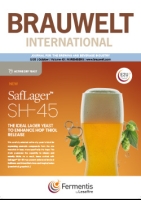Use of chlorine dioxide for disinfection of drinking, process and industrial water, for bottle disinfection and for disinfection of plants and plant components has been common practice in beverage production for decades. However, the oxidising disinfectant causes corrosion on metal surfaces. The corrosion behaviour of austenitic chromium-nickel steel 1.4301 (304SS, V2 A) at different concentrations of chlorine dioxide has been investigated in the Dr. Küke GmbH laboratory, Wedemark. A chlorine dioxide solution containing hydrochloric acid and a pH neutral one was used.
Although the annual world beer production is steadily increasing, the hop production is decreasing. A reason is the technological progress made on the conversion rate leading to a better utilization of the α-acids towards the iso-α-acids during beer production. However, scientific data on the evolution of the hoppy aroma of beer is rare and the hop-derived aroma of beer, or more precisely the volatile composition of hops, is significantly influenced by the brewing process. In order to introduce unique flavor profiles into beer, huge amounts of hops are still necessary. For this reason, this study traces the changes of the hop-derived volatiles occurring during beer manufacturing of single hopped beers with and without additional dry hopping.
With a present-day capacity of over 8 million hectolitres, St. James’s Gate in Dublin is the world’s biggest stout brewery. Sustainable brewing was most definitely a paramount focus. Dramatically high energy savings in the brewing process for the global Guinness brand are being achieved by the Diageo Group in its new brewhouse using the Steinecker EquiTherm. For this new construction job called “Project Phoenix” Krones supplied three brewing lines, including Europe’s largest lauter tun in the new Brewhouse No. 4 at St. James’s Gate Brewery.
Karbach Brewing Company in Houston is producing its first beers on a new brewhouse supplied by Ziemann, Ludswigsburg/Germany. As part of Karbach’s capacity expansion, Ziemann also supplied the new fermentation tanks and a state of the art automation system.
Olympic Brewery in Greece was one of the first breweries to opt for a new system for beer stabilization with regenerated, reusable PVPP. The main selection criteria were the compactness of the modular system which runs 24/7 with no downtimes, short setup times for system startup or shutdown and short switching times.
Krones’ Steinecker plant in Freising has dispatched two Pegasus C lauter tuns, each holding 210,000 litres, to Munich-Langwied – packed in four halves, each measuring 11.50 m in diameter. Transported during six hours of the night as a special consignment with a convoy of four low-loaders, these components kicked off a delivery marathon, extending up to the end of January 2015, for Paulaner’s new brewery, which is currently taking shape on a 15-hectare site in the west of Munich and has initially been dimensioned for an output of 3.5 million hectolitres of beer (at its original premises, Paulaner was most recently brewing 3 mio hl).
Modern human-machine interfaces place efficient completion of working processes, an attractive visual design and an optimized usage experience at the forefront of human-machine interaction. KHS, one of the worldwide market leaders in the filling and packaging industry, has developed a new solution for the operation and control of production lines and machines in the drinks industry, on the basis of zenon HMI/SCADA software. It has already received many awards.
Calculation of concentration | Boiling off unwanted DMS is both labour and cost intensive. The objective of this series of publications is aimed at calculation of DMS formation in the brewhouse in order to predict DMS and DMSP contents at the end of wort preparation. In part 1 (BRAUWELT International no 4, 2014, pp. 217-219), equations for calculating evaporation and reconstitution were detailed. The present article describes the necessary equation parameterisation and provides an overview of various combinations of these equations in order to calculate and thus predict the unit operations in the brewhouse in terms of DMS stripping and reconstitution.
With the Innoline MES KHS provides a manufacturing execution system (MES) which is specially tailored to the applications of the beverage industry. The system is based on the HYDRA MES from MPDV Mikrolab GmbH, one of the leading providers in this sector. They were able to win the Bitburger Brewery Group as pilot customer. The mutual aim was to integrate the requirements of the beverage industry into this system. Much time and expertise was invested to achieve an increase in the technical efficiency of plant technology, an improved production planning, efficient supply of materials and a reduction in the number of line downtimes.
In the previous articles of this series the mash agitator Colibri, the lauter tun Lotus and the internal boiler Shark have been presented. All this equipment has been installed for the first time in the new brewhouse of the Karmeliten Brauerei in Straubing. Part 4 of this series described a potential supplementary equipment to this concept: the dynamic coolship Diamond. The fifth and last part of this series includes a summary of the practical experiences, gained within half a year of operation, as well as the results of the brewhouse acceptance test.
In the previous articles of this series the mash agitator Colibri, the lauter tun Lotus and the internal boiler Shark were presented. All this equipment has been installed in the Karmeliten Brauerei in Straubing for the first time. Part 4 of this series describes the continuous coolship Diamond as a potential supplementary equipment to this concept. The fifth and last article of this series will include a summary and discussion of the results of the brewhouse acceptance test.



